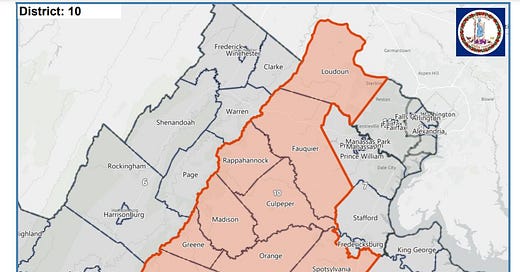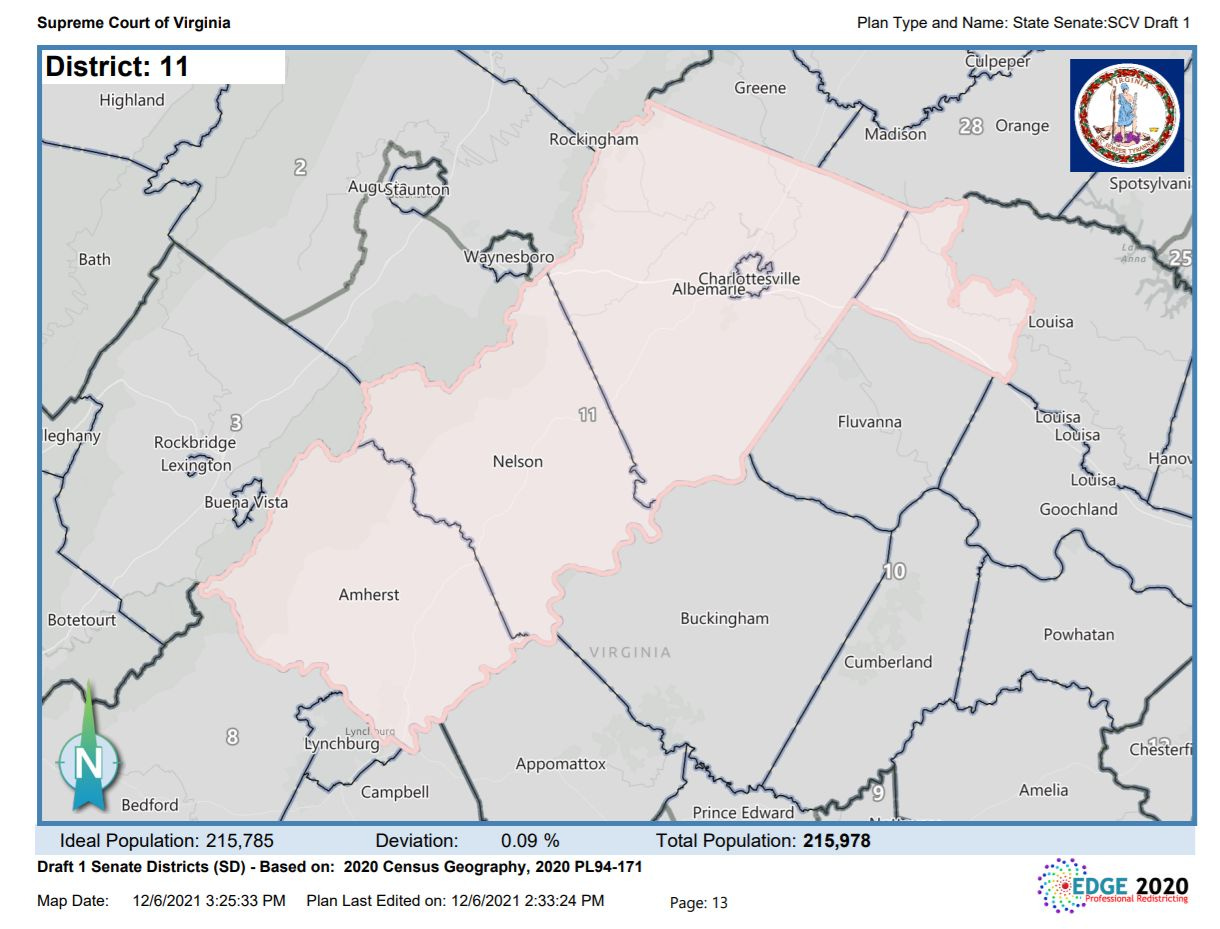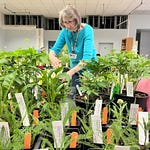In today’s first Patreon-fueled shout-out:
The Plant Northern Piedmont Natives Campaign an initiative that wants you to grow native plants in yards, farms, public spaces and gardens in the northern Piedmont. Winter is here, but spring isn’t too far away. This is a great time to begin planning for the spring. Native plants provide habitat, food sources for wildlife, ecosystem resiliency in the face of climate change, and clean water. Start at the Plant Northern Piedmont Natives Facebook page and tell them Lonnie Murray sent you!
On today’s show:
Governor-elect Youngkin pledges to remove Virginia from the Regional Greenhouse Gas Initiative
Two mapmakers hired by the Virginia Supreme Court have laid out their boundaries in advance of public hearings
Albemarle County Supervisors agree to dedicate more resources to monitoring blighted properties and enforcing rules
The Charlottesville Tree Commission gets a first look at data showing a continue decline in tree cover in the city
The Carter G. Woodson Institute celebrates forty years of research into the African diaspora
Covid update
A quick look at COVID-19 numbers, which continue to an upward trend. Today the percent positivity increased to 7.9 percent and the Virginia Department of Health reports another 3074 new cases. That number includes another 100 cases in the Blue Ridge Health District. There are another three new fatalities reported in the Blue Ridge Health District today.
Redistricting
Albemarle County may be represented by two people in the U.S. House of Representatives if a map drawn under the direction of the Virginia Supreme Court is adopted. This fall, the first Virginia Redistricting Commission failed to reach consensus on new legislative maps for the U.S. House and the two houses of the General Assembly. That left the task to two special masters appointed by the Virginia Supreme Court.
“These maps reflect a true joint effort on our part,” reads a memo written by Sean P. Trende and Bernard F. Grofman. “We agreed on almost all issues initially, and the few issues on which we initially disagreed were resolved by amicable discussion.”
In their memo, the pair of Special Masters noted they ignored incumbents when drawing the map. In doing so, 7th District Congresswoman Abigail Spanberger would no longer be in the same district. They also noted that the district numbers might change.
Under the Congressional map, northern Albemarle County would be in a district that stretches north to Loudoun County and the Maryland border. Charlottesville and southern Charlottesville would be in a district that stretches to the North Carolina and contains much of the Southside. Crozet would be split between the two districts.
Under the House of Delegates map, Charlottesville and much of Albemarle’s urban ring would be in the 54th District and most of Albemarle would be in the 55th. This district would include the western portion of Louisa County and an eastern sliver of Nelson County. Greene would be in a district with half of Orange County, half of Culpeper County, and all of Madison County. Fluvanna would be in a district with Buckingham, Cumberland, and Appomattox counties, as well as the western half of Goochland.
Under the Senate map, Albemarle and Charlottesville would be within the 11th District along with Amherst and Nelson counties, as well as the western portion of Louisa County. The rest of Louisa would be in the 10th, as well as all of Fluvanna County. Greene County would be in the 28th with all of Madison, Orange, and Culpeper counties.
The two public hearings will be held virtually on December 15 and December 17. People who wish to comment should email to redistricting@vacourts.gov to notify the Court a day in advance of that desire.
“The Court recognizes that the establishment of voting districts for the Virginia General Assembly and Virginia’s congressional representatives will have significant and lasting impact on every Virginian,” reads the notice for the public hearing.
Written comments will be taken through December 20 at 1 p.m.
RGGI withdrawal?
According to multiple accounts, Governor-elect Glenn Youngkin told the Hampton Roads Chamber of Commerce that he will remove Virginia from an interstate compact that seeks to reduce carbon emissions through a cap-and-trade system. Youngkin called it a carbon tax and said he will issue an executive order to withdraw Virginia from the Regional Greenhouse Gas Initiative (RGGI) in order to reduce energy costs for consumers. Since joining in July 2020, Virginia has received $227.6 million in proceeds from auctions with the funds designated for climate change mitigation efforts.
Read Sarah Vogelsong’s story in the Virginia Mercury to learn more. (Youngkin pledges to pull Virginia from carbon market by executive order).
According to a press release from the Hampton Roads Chamber, Youngkin said he will seek to eliminate the grocery tax, suspend the gas tax for a year, and lower taxes for veterans.
Also yesterday, a recount in the 91st House District confirmed that Republican A.C. Cordoza defeated Democratic incumbent Martha Mugler in the November 2 election, though the margin of victory shrank from 94 votes to 64 votes. That gives the Republicans a 52-48 majority in the House of Delegates next year.
Preservation awards
A community group that seeks to raise awareness of historic structures and preserve them has issued their annual awards and grants. Preservation Piedmont offered three small grants to the following groups. All copy below comes from them:
● The Albemarle Charlottesville Historical Society, for their project to restore and keep active the Hatton Ferry, a small historic ferry across the James River.
● Burley Varsity Club, for the publication of Unforgettable Jackson P. Burley High School, a book about the history of Jackson P Burley High School, built by Charlottesville and Albemarle to provide a modern high school for its African American communities and known for its superlative athletic teams and academic accomplishments.
● Friends of Gladstone Depot (with assistance from the Nelson County Historical Society), for their efforts to move the Gladstone depot to a new site and repurpose the facility as a community center.
There were seven community awards. Here are six of them.
● A Special Recognition Award to the University of Virginia, for thoughtful community engagement in the development of the Memorial to Enslaved Laborers.
● An Adaptive Reuse Award to Armand and Bernice Thieblot, owners of the Quarry Gardens at Schuyler, for their dedication to adaptive reuse of the Quarry Gardens, and for making it available to the public.
● An adaptive Reuse Award to The Claudius Crozet Blue Ridge Tunnel Foundation and Allen Hale, for their efforts to preserve and make publicly available one of the great engineering feats of the world, the Blue Ridge Railroad Tunnel.
● A Preservation Award to owners Tim Mullins and Tara Crosson, and builder Craig Jacobs, for thoughtful rehabilitation of an important Albemarle County structure, Findowrie (2015 C-Ville Weekly article).
● A Design Award to Charlottesville Quirk, LLC, for the Quirk Hotel's sensitive infill development on Charlottesville's West Main Street.
●The Martha Gleason Award goes to a member of the community who has exhibited sustained dedication to advocating for our community. This year the award went to Jean Hiatt for her role as a founding member of Preservation Piedmont, service on the Board of Architectural Review, and for contributions to oral histories and to the book Bridge Builders, and her active involvement with neighborhood associations and preservation advocacy. ”
Finally, something called Charlottesville Community Engagement was honored for some reason. I can report the award is a framed certificate and a tote bag.
Institute celebrated
Before the break, the Carter G. Woodson Institute for African American and Africa at the University of Virginia celebrates its 40th anniversary today. The Institute is named after a 20th century historian who established the first Black History Week. Learn more about the Institute and the work accomplished over the past four decades in a piece by Anne Bromley in UVA Today.
In today’s second Patreon-fueled shout-out, Code for Charlottesville is seeking volunteers with tech, data, design, and research skills to work on community service projects. Founded in September 2019, Code for Charlottesville has worked on projects with the Legal Aid Justice Center, the Charlottesville Fire Department, and the Charlottesville Office of Human Rights. Visit codeforcville.org to learn about those projects. I’m told that a native plants database may be in the works?
Tree canopy declining
A contractor working on the calculation of the Charlottesville’s tree canopy has turned in the first set of data. Chris Gensic is with the city’s Parks and Recreation Department and he spoke to the Tree Commission on Tuesday. (watch the meeting)
“We have lost some canopy,” Gensic said. “I think their average right now is in the 40 percent plus a little bit of change, not quite to 41 percent. I think the first one we did, we were in the 47 realm maybe in ‘08.”
That number dropped further to 45 percent in 2015. (Urban Canopy Reports)
Gensic said he is going through the data neighborhood by neighborhood to see how it compares to previous tree canopy reports.
“Is it that the aerial photo is of a different quality?” Gensic asked. “We’re trying to keep these five-year increments pretty consistent in terms of how data is gathered and how its analyzed so we can say consistently that the loss or gain in trees is actual trees but not an anomaly in the data.”
Gensic said a final report will be ready by sometime in January but could be available by the end of the month. He asked Tree Commissioners to take a look at the preliminary data to see what their interpretations are. The data collection was delayed by the pandemic.
Fighting blight
A year ago, the Albemarle Board of Supervisors asked the Department of Community Development to look into ways the county might be able to compel property owners to maintain their property to keep it out of blighted status. Jodie Filardo, the county’s director of community development, addresses supervisors on December 1, 2021.
“We’re here today to seek Board input on whether to take measures to establish a new program under the Virginia Maintenance Code to continue with focused tools and measures using spot blight abatement,” Filardo said.
Priority number six of the county’s strategic plan is to “revitalize aging urban neighborhoods.”
Filardo returned to the Board on December 2 with options about how to proceed. But first, a definition.
“Blighted property is defined as a structure or improvement that is dilapidated or deteriorated because it violates minimum health and safety standards,” Filardo said.
Filardo said in the past year, the county has received six complaints about individual properties, and five of these have approved maintenance plans in place. One of these properties will be demolished.
“If any of the properties with approved maintenance plans do not meet satisfactory progress toward compliance before you, they will be brought before you with the spot blight ordinance,” Filardo said.
Amelia McCulley is the outgoing deputy director of community development. She briefed the board about options to expand the enforcement in the county under the Virginia Maintenance Code to items beyond health and safety, such as peeling paint, crumbling siding, and broken gutters. Staff is recommending a phased approach.
“An option for the Board is to not go entirely responsive but to prioritize our aging urban neighborhoods by being proactive in one to two neighborhoods each year,” McCulley said. “Second point would be that we recommend a focused enforcement that prioritizes public health and safety and that we adopt a portion of the maintenance code and that would be Section 3 which focuses on the exterior of the structures.”
McCulley said hiring new staff to fully enforce the VMC would not be cheap. The first year would cost half a million with an ongoing cost of $390,000 a year. Adoption of the full code would cost more.
“Adoption of the full maintenance code with proactive enforcement countywide is estimated to have a first year cost of $888,001 and an ongoing cost of $679,382,” McCulley said.
Supervisor Donna Price said she was not satisfied that the status quo was not sufficient. She had brought up three properties at the December 2020 work session and has suggested others since then.
“And it’s clear that what we currently have been doing has not been able to fully address the blighted unsafe property situation,” Price said. “I think of the three I first brought up, pretty much the only thing that was achieved of significance would be that an abandoned minivan was removed from the property and some openings were boarded up. But other than that, the properties are still out there and just as blighted as they would otherwise appear.”
Price said she did not favor adopting the full maintenance code in part due to the potential for unintended consequences and costs. Having heard that the Office of Equity and Inclusion has potential concerns, Price said some distinctions need to be made.
“To me, one of the things that has to be taken into account and this ties into the Office of Equity and Inclusion’s participation in this process, is the distinction between those who cannot take care of their property primarily due to financial resources versus those who simply will not or refuse to do so,” Price said. “One of the things I am not interested in is providing a financial benefit to those who refuse to take care of their property.”
Price leaned towards some form of adoption of the Virginia Maintenance Code.
Supervisor Bea LaPisto-Kirtley suggested revisiting the topic in another year. She said thought the spot blight abatement might suffice for now.
Supervisor Diantha McKeel also supported using the existing program and agreed with staff’s recommendation to hire a dedicated staffer for this purpose. That decision will come during the development of the FY23 budget and whether to spend $110,000 for this project.
“I think the Virginia Maintenance Code sounds not like its not going to get us to where we really need to be, and it’s prohibitively expensive, it would appear,” McKeel said.
McKeel said she wants a focus on rental properties in the urban areas that are owned by people out of the community.
Supervisor Ned Gallaway said he would support eventually adopting the Virginia Maintenance Code.
“We have to be doing something proactive no matter what phase we do to help people that are burdened to be able to get their houses back into a healthy and safe environment for themselves,” Gallaway said. “Maybe that’s the tack I take here. A proactive approach would identify that more quickly in my opinion.”
Aside from the budget discussion on hiring the new staffer, the topic will return to the Board of Supervisors in a year.
Special announcement of a continuing promo with Ting! Are you interested in fast internet? Visit this site and enter your address to see if you can get service through Ting. If you decide to proceed to make the switch, you’ll get:
Free installation
Second month of Ting service for free
A $75 gift card to the Downtown Mall
Additionally, Ting will match your Substack subscription to support Town Crier Productions, the company that produces this newsletter and other community offerings. So, your $5 a month subscription yields $5 for TCP. Your $50 a year subscription yields $50 for TCP! The same goes for a $200 a year subscription! All goes to cover the costs of getting this newsletter out as often as possible. Learn more here!


















Share this post